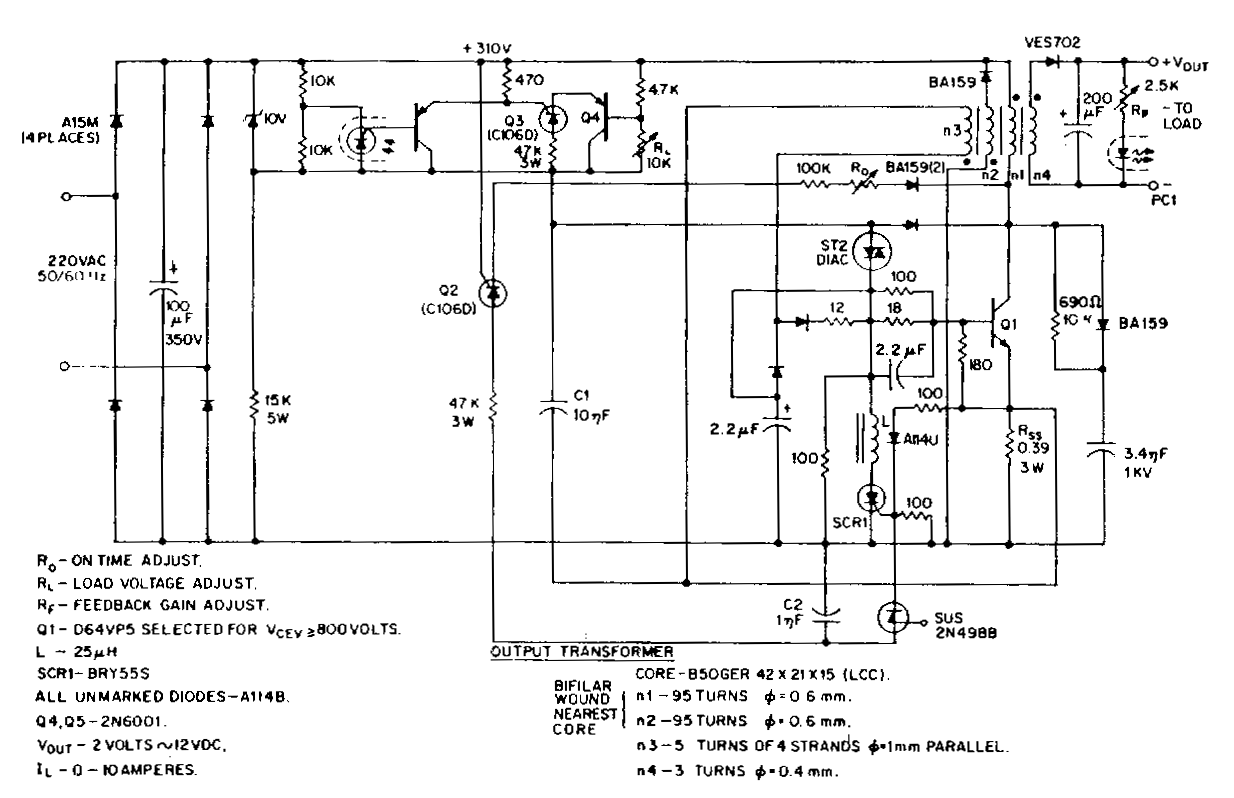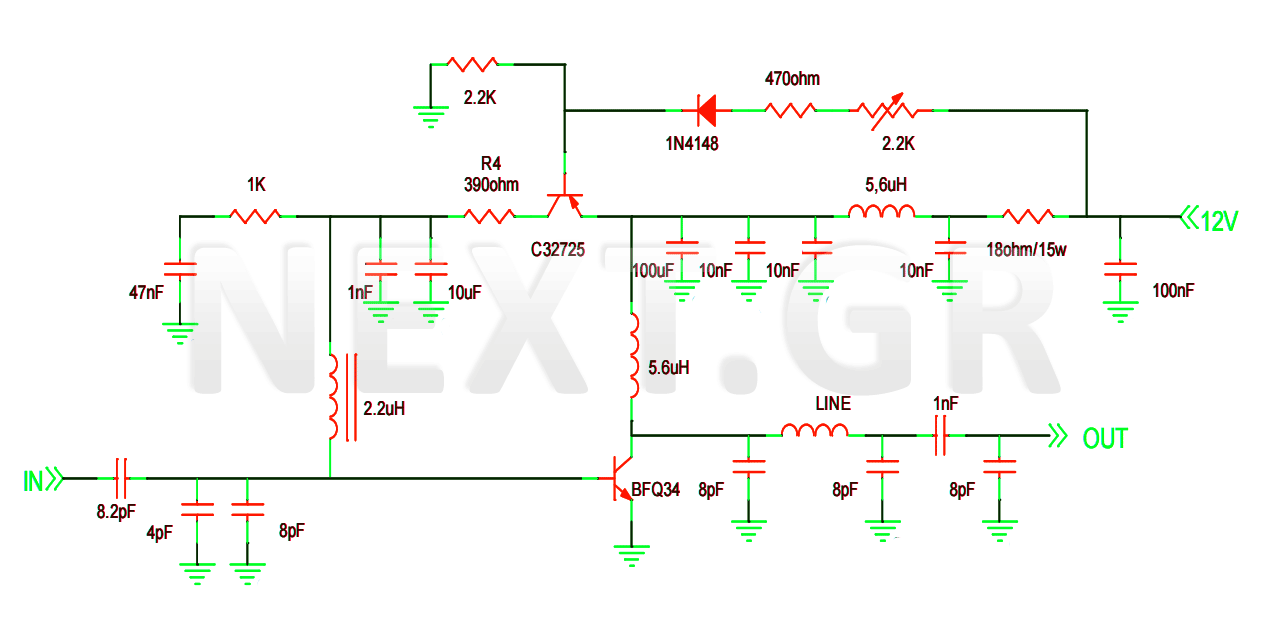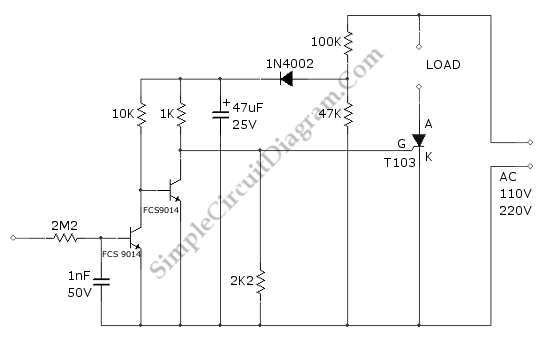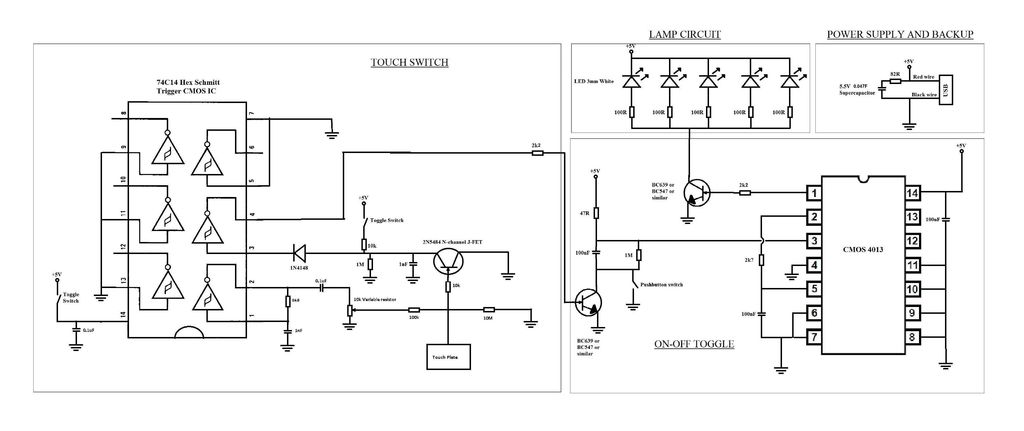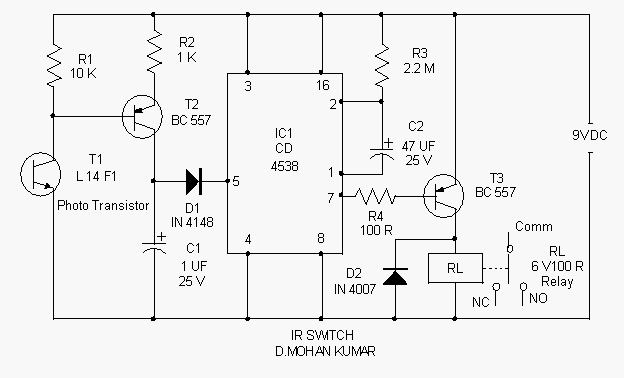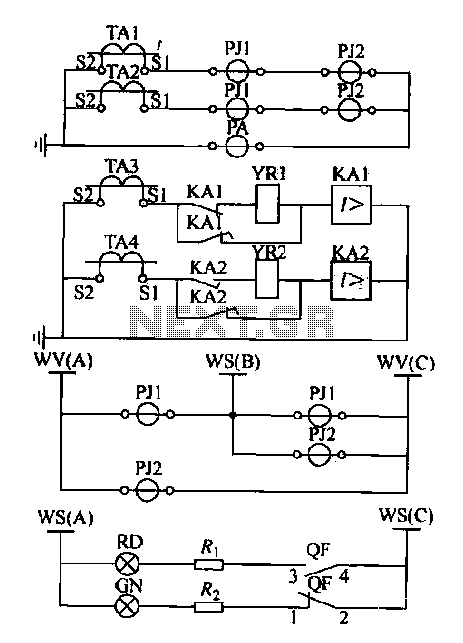
2 line intercom plus a telephone changeover switch

Typically, a single telephone is connected to a telephone line. If an additional telephone is needed at a distance, a parallel line is installed for connecting the second telephone. This straightforward parallel line arrangement presents issues such as loss of privacy and interference from the other phone. The circuit described here addresses these concerns. Under normal conditions, two telephones (telephone 1 and telephone 2) can function as an intercom while telephone 3 is connected to the exchange lines. In changeover mode, the exchange line is disconnected from telephone 3 and connected to telephone 2. To operate in intercom mode, the user lifts the handset of phone 1 and presses switch S1, causing buzzer PZ2 to sound. Concurrently, a side tone is heard in the speaker of phone 1's handset, allowing the user at phone 2 to lift their handset and begin a conversation. A similar process is followed for initiating a conversation from phone 2 using switch S2. In this operational mode, a 3-pole, 2-way slide switch S3 is utilized as illustrated in the accompanying figure. In changeover mode, switch S3 is employed to reroute the telephone line for use by telephone 2. The switch is normally set to intercom mode, connecting telephone 3 to the exchange line. Prior to changing the exchange line to telephone 2, the user at telephone 1 may inform the user at telephone 2 (in intercom mode) of the impending changeover. Once switch S3 is toggled to the alternate position, the 12V supply is disconnected, and telephones 1 and 3 do not receive voltage or ring tones via the ring-tone-sensing unit. After switch S3 is flipped to allow telephone 2 to use the exchange line, if the switch is not returned to its original position after the call, subsequent calls to the exchange lines will be directed to telephone 2, while the ring-tone-sensing circuit remains operational. This setup allows the user at telephone 3 to be aware that a call has occurred. If the handset of telephone 3 is lifted, it will be found inactive. To reactivate telephone 3, switch S3 must be returned to its standard position.
The circuit design incorporates a robust intercom system that allows seamless communication between two telephones while maintaining the functionality of a third telephone connected to the main exchange line. The implementation of a 3-pole, 2-way slide switch (S3) is crucial for managing the changeover between intercom and exchange line modes. This switch not only facilitates the routing of calls but also ensures that the power supply to the telephones is effectively controlled to prevent interference.
In the intercom mode, the buzzer (PZ2) serves as an alert mechanism, signaling the initiation of a conversation. The side tone feature enhances the user experience by providing auditory feedback to the person using telephone 1, indicating that the communication line is active. The design ensures that both telephones in intercom mode can communicate without the risk of cross-talk or interference from the exchange line, thus preserving privacy.
The circuit's operation is contingent on the proper toggling of switch S3. When switched to the changeover position, the supply voltage to telephones 1 and 3 is cut off, preventing them from ringing or being active during the call on telephone 2. This design consideration is critical for maintaining the integrity of the exchange line connection while allowing for intercom functionality.
Furthermore, the ring-tone-sensing unit remains functional even after the changeover, providing feedback to the user of telephone 3 regarding incoming calls. This feature is particularly advantageous, as it keeps the user informed of call activity without compromising the primary function of the intercom system.
In summary, this circuit design effectively addresses the common challenges associated with parallel telephone line connections by integrating intercom functionality with a changeover mechanism, ensuring both privacy and operational efficiency.Usually a single telephone is connected to a telephone line. If another telephone is required at some distance, a parallel line is taken for connecting the other telephone. In this simple parallel line operation, the main problem is loss of privacy besides interference from the other phone.
This problem is obviated in the circuit presented here. U nder normal condition, two telephones (telephone 1 and 2) can be used as intercom while telephone 3 is connected to the lines from exchange. In changeover mode, exchange line is disconnected from telephone 3 and gets connected to telephone 2.
For operation in intercom mode, one has to just lift the handset of phone 1 and then press switch S1. As a result, buzzer PZ2 sounds. Simultaneously, the side tone is heard in the speaker of handset of phone 1. The person at phone 2 could then lift the handset and start conversation. Similar procedure is to be followed for initiation of the conversation from phone 2 using switch S2. In this mode of operation, a 3-pole, 2-way slide-switch S3 is to be used as shown in the figure. In the changeover mode of operation, switch S3 is used to changeover the telephone line for use by telephone 2.
The switch is normally in the intercom mode and telephone 3 is connected to the exchange line. Before changing over the exchange line to telephone 2, the person at telephone 1 may inform the person at telephone 2 (in the intercom mode) that he is going to changeover the line for use by him (the person at telephone 2). As soon as changeover switch S3 is flipped to the other position, 12V supply is cut off and telephones 1 and 3 do not get any voltage or ring via the ring-tone-sensing unit.
Once switch S3 is flipped over for use of exchange line by the person at telephone 2, and the same (switch S3) is not flipped back to normal position after a telephone call is over, the next telephone call via exchange lines will go to telephone 2 only and the ring-tone-sensing circuit will still work. This enables the person at phone 3 to know that a call has gone through. If the handset of telephone 3 is lifted, it is found to be dead. To make telephone 3 again active, switch S3 should be changed over to its normal position. 🔗 External reference
The circuit design incorporates a robust intercom system that allows seamless communication between two telephones while maintaining the functionality of a third telephone connected to the main exchange line. The implementation of a 3-pole, 2-way slide switch (S3) is crucial for managing the changeover between intercom and exchange line modes. This switch not only facilitates the routing of calls but also ensures that the power supply to the telephones is effectively controlled to prevent interference.
In the intercom mode, the buzzer (PZ2) serves as an alert mechanism, signaling the initiation of a conversation. The side tone feature enhances the user experience by providing auditory feedback to the person using telephone 1, indicating that the communication line is active. The design ensures that both telephones in intercom mode can communicate without the risk of cross-talk or interference from the exchange line, thus preserving privacy.
The circuit's operation is contingent on the proper toggling of switch S3. When switched to the changeover position, the supply voltage to telephones 1 and 3 is cut off, preventing them from ringing or being active during the call on telephone 2. This design consideration is critical for maintaining the integrity of the exchange line connection while allowing for intercom functionality.
Furthermore, the ring-tone-sensing unit remains functional even after the changeover, providing feedback to the user of telephone 3 regarding incoming calls. This feature is particularly advantageous, as it keeps the user informed of call activity without compromising the primary function of the intercom system.
In summary, this circuit design effectively addresses the common challenges associated with parallel telephone line connections by integrating intercom functionality with a changeover mechanism, ensuring both privacy and operational efficiency.Usually a single telephone is connected to a telephone line. If another telephone is required at some distance, a parallel line is taken for connecting the other telephone. In this simple parallel line operation, the main problem is loss of privacy besides interference from the other phone.
This problem is obviated in the circuit presented here. U nder normal condition, two telephones (telephone 1 and 2) can be used as intercom while telephone 3 is connected to the lines from exchange. In changeover mode, exchange line is disconnected from telephone 3 and gets connected to telephone 2.
For operation in intercom mode, one has to just lift the handset of phone 1 and then press switch S1. As a result, buzzer PZ2 sounds. Simultaneously, the side tone is heard in the speaker of handset of phone 1. The person at phone 2 could then lift the handset and start conversation. Similar procedure is to be followed for initiation of the conversation from phone 2 using switch S2. In this mode of operation, a 3-pole, 2-way slide-switch S3 is to be used as shown in the figure. In the changeover mode of operation, switch S3 is used to changeover the telephone line for use by telephone 2.
The switch is normally in the intercom mode and telephone 3 is connected to the exchange line. Before changing over the exchange line to telephone 2, the person at telephone 1 may inform the person at telephone 2 (in the intercom mode) that he is going to changeover the line for use by him (the person at telephone 2). As soon as changeover switch S3 is flipped to the other position, 12V supply is cut off and telephones 1 and 3 do not get any voltage or ring via the ring-tone-sensing unit.
Once switch S3 is flipped over for use of exchange line by the person at telephone 2, and the same (switch S3) is not flipped back to normal position after a telephone call is over, the next telephone call via exchange lines will go to telephone 2 only and the ring-tone-sensing circuit will still work. This enables the person at phone 3 to know that a call has gone through. If the handset of telephone 3 is lifted, it is found to be dead. To make telephone 3 again active, switch S3 should be changed over to its normal position. 🔗 External reference
Warning: include(partials/cookie-banner.php): Failed to open stream: Permission denied in /var/www/html/nextgr/view-circuit.php on line 713
Warning: include(): Failed opening 'partials/cookie-banner.php' for inclusion (include_path='.:/usr/share/php') in /var/www/html/nextgr/view-circuit.php on line 713
